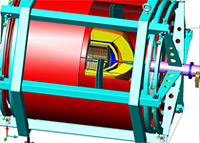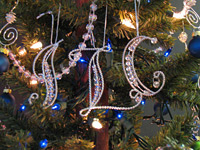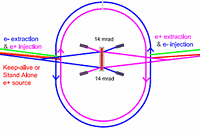 |
|
|
 |
Russian Scientists Get to Know KEKís Electron Gun

Yoshio Kamiya (Waseda University), Igor Kryachko (JINR), Toshikazu Takatomi(KEK) and Yury Korotaev (JINR) worked together on the photo-cathode RF gun at KEK. |
An electron gun is the device that supplies the electrons for an electron accelerator. There are mainly two types of electron guns: thermal-electron guns and photo-cathode RF guns. A thermal-electron gun is used for cathode-ray tubes in television sets and for electron microscopes. When a piece of metal is heated, it produces electrons. These electrons are accelerated by an electric field. In high-energy accelerators, radio-frequency electromagnetic waves are used to generate the field. In a thermal-electron gun, the beam bunch is compressed by a device called buncher, and it generates bunches in about ten picoseconds. Timing is adjusted so that the bunch of this electron beam may ride on the wave of the radio frequency acceleration electric field, and it accelerates.
Read more...
-- Nobuko Kobayashi |
 |
|
|
 |
|
Upcoming meetings, conferences, workshops
European LC WS Meeting
8-9 January 2007
Daresbury Laboratory, UK
MAC meeting
10-12 January 2007
Daresbury Laboratory, UK
USPAS
Texas A&M University
15-26 January 2007
ILC Detector Test Beam Workshop
Fermilab, Batavia, Illinois
17-19 January 2007
 The 9th ACFA ILC Physics & Detector Workshop & ILC GDE Meeting The 9th ACFA ILC Physics & Detector Workshop & ILC GDE Meeting
IHEP, Beijing
4-7 February 2007
Annual WILGA Conference
Warsaw University of Technology Resort, Poland
21-27 May 2007
 LCWS 2007 LCWS 2007
Hamburg, Germany
30 May - 4 June 2007
IEEE EUROCON 2007
Warsaw, Poland
9-12 Sept 2007
|
|
|
 = Collaboration-wide Meetings = Collaboration-wide Meetings
GDE Meetings Calendar
|
|
|
 |
 |
|
|
 |
ILC Detector in the Making: The 4th Detector Concept

Artistís impression of the '4th concept' detector. |
In July, ILC NewsLine provided overviews of the four detector concepts and of the Global Large Detector (GLD) concept. In October and November we took a closer look at the Silicon Detector (SiD) concept and the Large Detector Concept LDC. This week features the last ILC detector concept: the '4th concept'.
The newer ILC detector concept is the only one which does not rely on a particle flow algorithm for event reconstruction. "The only similarity between our calorimeter and those of the other concepts is that we call it a calorimeter, the idea is totally different," said John Hauptman, physicist at Iowa State University, contact person for the '4th concept'. At the ILC, good energy resolution is crucial to understand which kinds of events were produced at one e+ e- interaction point. The '4th concept' calorimeter uses the newly tested principle of dual readout of both scintillation light from all charged particles and, separately, Cerenkov light predominantly from the electromagnetic particles.
Read more...
-- Perrine Royole-Degieux |
 |
|
|
 |
Holiday Reading

No doubt which colours dominate on the Christmas tree in the GDE secretariat: ILC blue and ILC green of course! |
As NewsLine is taking a break for a week over the holidays, we (the editors) were getting a little worried about our readers – would you have enough interesting material to read next week (apart from RDR drafts, DCR chapters and companion documents, naturally)? The GDE Directors – who probably get through many books per year on long flights – didn't hesitate to help out. Here's what they recommend for some restful holiday reading. Interestingly, not a single text book or popular science piece is featured in the list! Enjoy and happy holidays!
Read more...
|
|
 |
 |
|
|
 |
The Evolving ILC Design: Centralising the Injectors

The new layout of the ILC central 4.5 km beam delivery system with accelerated beams entering from the left and right. The interaction points are now surrounded by electron and positron sources and the 6.7 km damping rings. |
I report today on another design change that has resulted from our ongoing cost to performance optimisation studies, which we are carrying out before finalising the ILC reference design. In my column from 5 October 2006, I described advances in our understanding of electron cloud effects. These studies allowed us to make a change to the ILC baseline from two positron rings receiving alternate bunches to one ring, in which we believe we can mitigate such effects. It turns out that making this change opened up the possibility to make a further change -- move both the positron and electron ring to a shared single tunnel at the centre of the ILC. The GDE Change Control Board (CCB) and the GDE Executive Committee recently approved this change. Compared to other changes we have made, this one is so visible that it dramatically changes the characteristic plan view of the ILC.
Read more...
-- Barry Barish
Director's Corner Archive |
 |
|
|
 |
From El Universo
17 December 2006
El mundo de la física de partículas pone a soñar a China
Read more in Spanish... |
|
From Science
15 December 2006
U.S. RESEARCH SPENDING: Scientists Feel the Pain as 2007 Budget Outlook Grows Dark
Read more... (Registration Required) |
|
From Interactions.org
15 December 2006
CERN Confident of LHC start-up in 2007
Read more... |
|
From le Monde
14 December 2006
Les cordes: une théorie trop belle pour être vraie?
Read more in French... |
|
From Physorg.com
14 December 2006
Alternative theory of gravity explains large structure formation -- without dark matter
Read more... |
|
ILC-Related Preprints
hep-ph/0612197
15 Dec 2006
Sudakov-Logarithmen in der elektroschwachen Wechselwirkung
hep-ph/0612183
14 Dec 2006
Off mass shell effects in associated production of the top quark pair and Higgs boson at a linear collider
EuroTev Report
EUROTeV-Report-2006-097
Status Report on Active Stabilisation of a Linear Collider Final Focus Quadrupole Mock-Up |
|

